Tuesday afternoon my encampment was finished,
this year including an evaporation pond. I bought a 1mm thick
plastic drop cloth and folded it into quarters to cover the possibility
of leakage on any one part of the sheet, draping it over some
large wooden canvas stretcher pieces which if they survived unwarped
would one day support a large painting. Anchoring the corners
with some rounded rocks brought from home, water poured into the
enclosed basin steadily evaporated although too slowly at first.
Later I placed small towels along the sides of the 'pond', so
one side would be above the water along the edge but not touching
the playa. This drew the water up the towel like in a candle wick
where it could be readily evaporated, at a third the time it took
relying on evaporation from the pool itself.
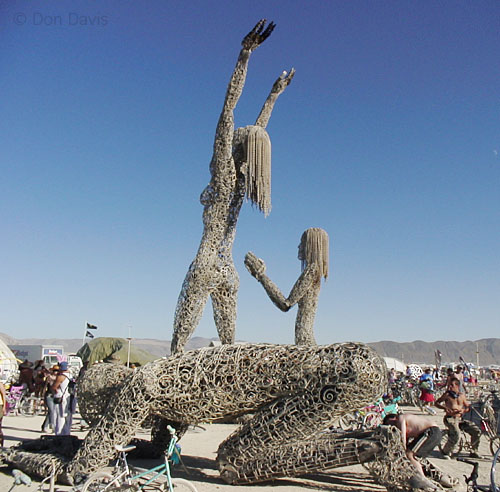 Before emerging for any length
of time outside my tent the routine established in earlier years
was followed: the soaked towel wash to start the day clean, the
application of sun block, this time in a spray form, to all exposed
areas such as upper limbs, face and especially nose and ears and
the back of the neck. My white sunshade covering worn in past
years was washed clean and ready for another week in the elements.
Covering my hair fairly tightly and anchored at my chin by a metal
ribbon clamp, my sides and back were also protected by the head
cover, similar to traditional Arab design. The order in which
I donned the layers of covering depended on my plans for the trip.
If I was going to bring a camera, the camera bag strap had to
go over me before the overall sun cover garment. If I was going
to bring my good industrial dust mask with the screw in filters
I had to put it over my head before the pith helmet was secured.
With my light mesh 'pith helmet' similar to that worn by many
postal workers, securely tied under my chin, I was ready to go.
Sometimes I carried water from the handlebars, but I soon found
you had to wind up the strap and hold it to prevent wild swinging
of half a gallon of water from affecting the stability of your
bike ride. At times I simply wore the canteen around my neck,
and I used it steadily.
Before emerging for any length
of time outside my tent the routine established in earlier years
was followed: the soaked towel wash to start the day clean, the
application of sun block, this time in a spray form, to all exposed
areas such as upper limbs, face and especially nose and ears and
the back of the neck. My white sunshade covering worn in past
years was washed clean and ready for another week in the elements.
Covering my hair fairly tightly and anchored at my chin by a metal
ribbon clamp, my sides and back were also protected by the head
cover, similar to traditional Arab design. The order in which
I donned the layers of covering depended on my plans for the trip.
If I was going to bring a camera, the camera bag strap had to
go over me before the overall sun cover garment. If I was going
to bring my good industrial dust mask with the screw in filters
I had to put it over my head before the pith helmet was secured.
With my light mesh 'pith helmet' similar to that worn by many
postal workers, securely tied under my chin, I was ready to go.
Sometimes I carried water from the handlebars, but I soon found
you had to wind up the strap and hold it to prevent wild swinging
of half a gallon of water from affecting the stability of your
bike ride. At times I simply wore the canteen around my neck,
and I used it steadily.
In Tuesday, my first daytime journeys in Black Rock City 2006,
I first noticed a constant column of bright dust seemingly emerging
from the path of incoming vehicles merging with that disturbed
by the center camp activity, all carried approximately along the
'noon' axis of the Tent City to envelope the giant 'Uchronia'
construction far beyond. This distant wonder spied from a distance
last night became an early goal once I got going around two in
the afternoon. It seemed magnified in its already considerable
size by a ground hugging layer of obscuring dust hiding its lower
parts. It looked like some odd shape rising out of the clouds.
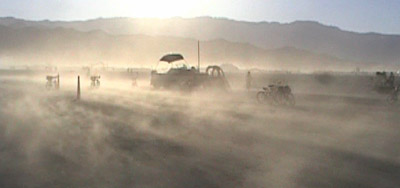 As I rode out the
dust swept past me and brought its own beauty to my surroundings.
Toward the Sun the dust being blown about would often hug the
ground as a luminous uneven mist much brighter than the textured
ground and assuming the graceful curving 'mares tail' forms of
cirrus clouds. They swirled across the flatness in graceful sweeping
flows with serpent like tendrils lazily winding along behind.
With the sun behind me, the ground hugging dust appeared darker
than the ground, the flowing detail merging into a thicker layer
of mist hugging part of the near horizon where most of the dust
was being driven. It was easy to dodge most of the approaching
localized dust storms while on a bike.
As I rode out the
dust swept past me and brought its own beauty to my surroundings.
Toward the Sun the dust being blown about would often hug the
ground as a luminous uneven mist much brighter than the textured
ground and assuming the graceful curving 'mares tail' forms of
cirrus clouds. They swirled across the flatness in graceful sweeping
flows with serpent like tendrils lazily winding along behind.
With the sun behind me, the ground hugging dust appeared darker
than the ground, the flowing detail merging into a thicker layer
of mist hugging part of the near horizon where most of the dust
was being driven. It was easy to dodge most of the approaching
localized dust storms while on a bike.
The distant wooden wonder on the horizon grew
as I approached into an astonishing revelation of inspired craziness.
As noted earlier, the overall shape looked something like an anvil
from my initial viewing angle. As I pedaled and started passing
it to my left, vast yawning arched openings came into view as
part of an open wooden structure built as a kind of dense latticework
in curving contours of flowing wood rather than in conventional
gridlike fashion. From other directions one was reminded of the
shape of a shortened ships hull.

This was the 'Uchronia', built by the Belgians,
Bankrolled by enlightened Belgian businessman Jan Kriekels and
designed by Arne Quinze, and among the most amazing sights ever
erected upon the playa. It was made of wood brought from that
country, with the ashes of its eventual immolation to be shipped
back home to enrich the soil for new groves of trees. This wooden
behemoth appeared from some angles like a frozen log jam or the
trees knocked over by Mt. Saint Helens, somehow nailed together
and erected to meet in a latticework arch overhead. Lines of applied
force were expressed by the 'flow' of the orientations of the
thousands of long boards, arching and curving like a more chaotic
expression of arched girder bridges. From outside the northern
openings one got the impression of something between the still
standing giant arch of ancient Ctesiphon and the latticework caverns
of 'Hanger One' in Moffett Field which once housed giant airships,
as interpeted by someone in a state of LSD adorned consciousness.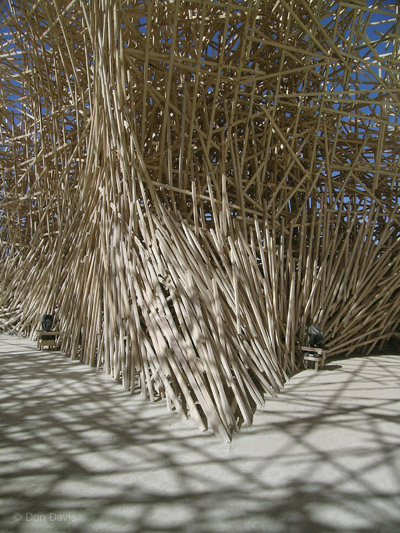
The more I paused at this unbelievable structure, the greater
became my appreciation for the work involved. A constant stream
of people, mostly on bicycles, were arriving to marvel at the
sight. One individual with a loudspeaker blared out "It looks
like a Belgian Waffle! I really like Belgian Waffles, I like the
jelly interiors, I REEELY like Belgian Waffles" and so on.
Perhaps from this occasion, the word spread nicknaming this structure
the 'Belgian Waffle', although its true name was 'Uchronia'. I
visited this major landmark each day, watching the finishing touches
being applied and the nightly transformation this structure underwent
from a kind of shrine to a major dance music spot. It became the
major attraction of the event and will stand in the collective
memory as one of the greatest manifestations of the spirit of
Burning Man.
Beyond the 'Uchronia' was a huge bamboo structure,
deceptively small looking in the distance. People were climbing
among the securely lashed bamboo poles, some as thick as human
limbs. In another relatively isolated part of the playa could
be seen a tall series of skeletal gothic arches lined up, defining
a kind of outline of the interior space of a cathedral in actual
size. The arches seemed about a hundred feet tall, and the dust
clouds made it appear ghostly as they moved unaffected among them.

Among the landmarks of this Burning Man were
a pair of giant mobile robotic plants. One was a tall crane modified
to be a sunflower with petals which could open and close and be
pointed any direction, the other one was a titanic articulated
Venus Fly Trap. These were based near a Circus sized tent on the
Esplanade, or inner street, between the 7:00 and 7:30 radial streets,
which served as a landmark visible from the entire playa for locating
my street. There was a climb in cubical room lined with mirrors
in which people were briefly shut inside with a light of some
kind, to wiggle it around and watch the rough infinity pictures
extending around them. many camps offering varied sights and experiences
were being visited by people aware of as well as new to Burning
man.
There were so many other attractions to be seen old and new I
cannot pretend to do justice to the entirety of the event or even
to all I experienced. One kind of moment I treasure and which
I experienced several times during the week was the 'What...the
...hell...is...THAT?!' type moment. Incredulity, astonishment,
and appreciation of something remarkable manifested here.
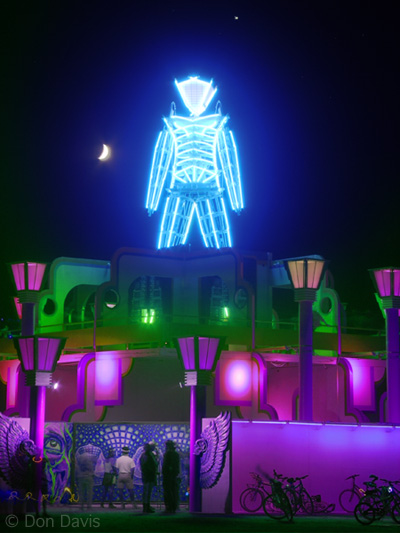
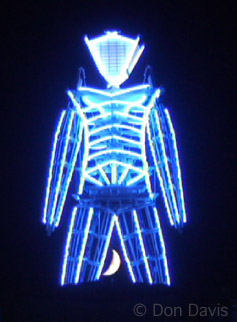
The Moon set later each night, and I made an
effort to obtain some photos of the Man with the crescent Moon
and the bright planet Jupiter in the early evening sky. It was
a rare occasion I decided to carry a tripod around, but for such
images it is a must. Taking several exposures without moving the
camera is needed in order to combine the best features properly
exposed in each into a single image. It is amazing to note how
well the human eye can see all these things at once, compared
to any single image of a camera. The Man at night was entrancing,
partly submerged in its multi leveled pedestal whose levels were
bathed in steadily changing floodlit colors. The blue neon of
the Man lit the surrounding playa on a cool ghostly radiance which
formed a kind of refuge from the darkness, It drew people on foot
and bicycles to itself like moths to a streetlight. The colorful
glowing necklace of the surrounding city flashed and roared itself
into the surrounding night. The use of private fireworks continued
its thankful decline, gone were the common red flares drifting
toward random parts of the Tent City. occasionally a number of
fireworks would rise and burst from this or that corner of the
City, but never for long due to stealth of the perpetrators or
intervention by Rangers.
PAGE 3

 Before emerging for any length
of time outside my tent the routine established in earlier years
was followed: the soaked towel wash to start the day clean, the
application of sun block, this time in a spray form, to all exposed
areas such as upper limbs, face and especially nose and ears and
the back of the neck. My white sunshade covering worn in past
years was washed clean and ready for another week in the elements.
Covering my hair fairly tightly and anchored at my chin by a metal
ribbon clamp, my sides and back were also protected by the head
cover, similar to traditional Arab design. The order in which
I donned the layers of covering depended on my plans for the trip.
If I was going to bring a camera, the camera bag strap had to
go over me before the overall sun cover garment. If I was going
to bring my good industrial dust mask with the screw in filters
I had to put it over my head before the pith helmet was secured.
With my light mesh 'pith helmet' similar to that worn by many
postal workers, securely tied under my chin, I was ready to go.
Sometimes I carried water from the handlebars, but I soon found
you had to wind up the strap and hold it to prevent wild swinging
of half a gallon of water from affecting the stability of your
bike ride. At times I simply wore the canteen around my neck,
and I used it steadily.
Before emerging for any length
of time outside my tent the routine established in earlier years
was followed: the soaked towel wash to start the day clean, the
application of sun block, this time in a spray form, to all exposed
areas such as upper limbs, face and especially nose and ears and
the back of the neck. My white sunshade covering worn in past
years was washed clean and ready for another week in the elements.
Covering my hair fairly tightly and anchored at my chin by a metal
ribbon clamp, my sides and back were also protected by the head
cover, similar to traditional Arab design. The order in which
I donned the layers of covering depended on my plans for the trip.
If I was going to bring a camera, the camera bag strap had to
go over me before the overall sun cover garment. If I was going
to bring my good industrial dust mask with the screw in filters
I had to put it over my head before the pith helmet was secured.
With my light mesh 'pith helmet' similar to that worn by many
postal workers, securely tied under my chin, I was ready to go.
Sometimes I carried water from the handlebars, but I soon found
you had to wind up the strap and hold it to prevent wild swinging
of half a gallon of water from affecting the stability of your
bike ride. At times I simply wore the canteen around my neck,
and I used it steadily.  As I rode out the
dust swept past me and brought its own beauty to my surroundings.
Toward the Sun the dust being blown about would often hug the
ground as a luminous uneven mist much brighter than the textured
ground and assuming the graceful curving 'mares tail' forms of
cirrus clouds. They swirled across the flatness in graceful sweeping
flows with serpent like tendrils lazily winding along behind.
With the sun behind me, the ground hugging dust appeared darker
than the ground, the flowing detail merging into a thicker layer
of mist hugging part of the near horizon where most of the dust
was being driven. It was easy to dodge most of the approaching
localized dust storms while on a bike.
As I rode out the
dust swept past me and brought its own beauty to my surroundings.
Toward the Sun the dust being blown about would often hug the
ground as a luminous uneven mist much brighter than the textured
ground and assuming the graceful curving 'mares tail' forms of
cirrus clouds. They swirled across the flatness in graceful sweeping
flows with serpent like tendrils lazily winding along behind.
With the sun behind me, the ground hugging dust appeared darker
than the ground, the flowing detail merging into a thicker layer
of mist hugging part of the near horizon where most of the dust
was being driven. It was easy to dodge most of the approaching
localized dust storms while on a bike.


